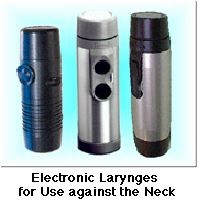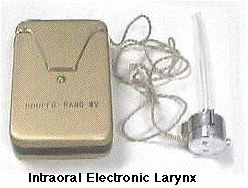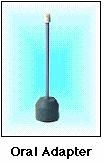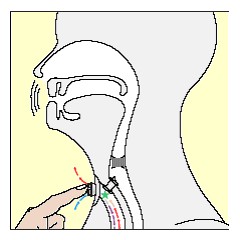Current
Therapies
Speech Generating
Devices
Speech
generating devices are used for communication by
individuals that do not have the ability to speak. These individuals
typically
have a diagnosis of severe apraxia, aphasia, aphonia, and/or
dysarthria, which
may be secondary to motor dysfunction, spasticity, tremor, rigidity, or
ataxia.
Their disability may result from a disease or congenital disorder, such
as
cerebral palsy, stroke, progressive amyotrophic lateral sclerosis,
multiple sclerosis, muscular dystrophy, traumatic or
congenital
quadriplegia, or traumatic brain injury.
Speech
Generating
Devices
or augementative communication devices enable an individul to
communicate
more effectively with others. A device assists an individual in
communicating
through printed words, speech or voice output, pictures, or any
combination of
these. Devices range from having basic components and performing
fundamental
language functions to having the ability to perform computer-like
functions and
control household appliances. SGDs are designed to be used as a
supplementary
mode of communication to augment existing communication strategies and
can be
configured or customized to address most communication needs.
There
are a variety of communication devices available. Devices can have a
single message
or multiple messages. Devices are categorizes based on the following
features:
- Speech Output-
Digitized (recorded human speech) or Synthesized
(electronic conversion
of text into speech).
- Message
Type- Prerecorded (messages that are stored) or Message
Formulation (can
spontaneously create novel messages).
- Access Method- Direct Physical Contact with Device or
Multiple Access
Methods (e.g.,
switch, mouse, joystick, etc.).
- Message Formulation Technique- Spelling only or Spelling
and Other
Methods.
Additionally,
devices have different selection sets (dynamic, static or both).
Dynamic sets
are similar to a computer monitor. The selection set or level changes automatically
on a dynamic screen as the user makes
choices. Static sets
have fixed symbol choices or levels
that can be manually changed. Most static sets Static sets usually have
a group
of letters, pictures and/or words on an overlay that is inserted or
attached to
the device.
Specialized switches are used with the scanning feature on some
devices. Specialized switches can be activated by almost any body part
or body action. Some examples of specialized switches include sip and
puff, myoelectrical, mercury, eye blink, and vibration.
Electrolarynx
About half the
laryngectomy population uses hand-held electrolarynges (EL) as their
primary means of communication. An
electrolarynx is an electronic
vibrating device that is placed against the neck and creates vibration
in the
mouth that the speaker then articulates into speech. It is a
medical device used to produce clearer speech by those who have lost
their original voicebox, usually due to cancer of the
larynx. There
are several such battery powered devices on
the market. With one
type of unit, you place it against your throat, push a button, and the
machine
transmits a vibration noise to your throat which you then form into
words and
sounds with your lips, teeth, and tongue. With the second type, the
vibration
sound is transmitted directly into your mouth via a small tube.
Most
artificial or electrolarynges are
made to be
used by holding them against the outside of the neck, but some have
oral
adapters, particularly useful when the throat is swollen or sensitive.
Some of
these brand names are Servox, TruTone, Romet, Optivox, Nu-Vois, Denrick
and
Solatone.
Currently available
EL devices produce speech that sounds non-human (mechanical, robotic,
monotone), has reduced intelligibility and loudness, and draws
undesirable attention to the user. The poor quality of EL speech has
been traced to limitations in performance of current EL sound
generating transducers, and to the loss of the fine control of pitch,
amplitude, and voice onset and offset timing that is normally provided
by the laryngeal mechanism.
The advantages of the electrolarynx are it's short learning
time, ability to use immediately postop,
and relative availability and low cost.
Voice
Prosthesis
Voice
prosthesis allows the production of the much preferred
"tracheo/esophageal" (TE) voice after total
laryngectomy. In this method, a channel (called
a
“voice-fistula”) is made
through the wall between the windpipe and the gullet (the TE-wall).
Voice functions are generally replaced with a voice
prothesis placed in the tracheo-esophageal puncture created by the
surgeon. The voice
prosthesis vibrates the esophageal tissue in lieu of the larynx.
When you
exhale while covering the stoma at the same time, the air from the
lungs will
be pushed through this channel into the gullet where an esophageal
voice is
produced. To prevent food and liquids from passing into the lungs via
the
fistula, a voice prosthesis is inserted. A voice prosthesis is a
one-way valve
that allows exhaled air to pass freely. The valve closes during
swallowing to
prevent food and liquids from entering the lungs.The main benefit of
this
technique is that you can get your new voice fairly soon after surgery.
A
secondary benefit is your ability to control the volume, intonation and
length
of sentences.
The Provox
voice prosthesis is made of soft silicon and it can stay in
place for a
long time. The Provox voice prosthesis has a unique, strong
construction with a
low-resistance valve molded in one piece with the prosthesis. The valve
seals
against a stabilizing, non-deformable blue ring made of hard plastic.
The
prosthesis has stable flanges to keep it in place. The
Provox voice prosthesis can be inserted at the time of surgery, some
weeks
after surgery or whenever convenient.
Talking
with a voice prosthesis is easy and requires little training. Just like
normal
speech, you use the air you breath out. Simply cover the stoma with
your finger
and gently exhale. The air is led through the voice prosthesis into the
gullet
where the wall vibrates and creates an esophageal voice. You can vary
your new
TE voice, both in loudness and pitch, in the same manner as a normal
voice, by
changing the flow of air as you exhale.
|
|

Static SGD

Dynamic SGD

How Electrolarynx works

Assorted Electrolarynx devices



Voice prosthesis inserted in the trachea-esophagus
channel

Provox voice
Prosthesis

|